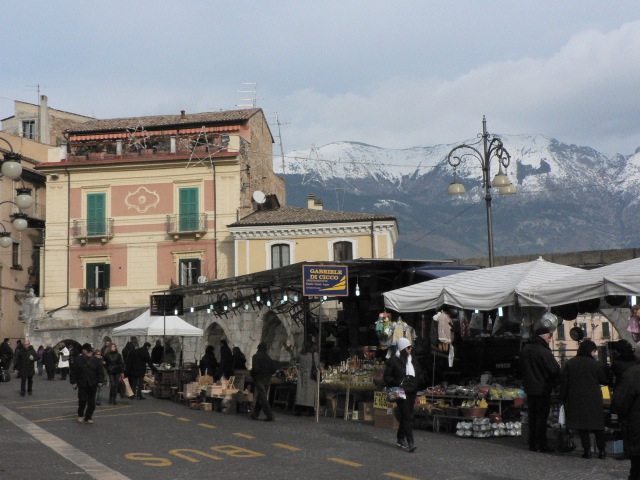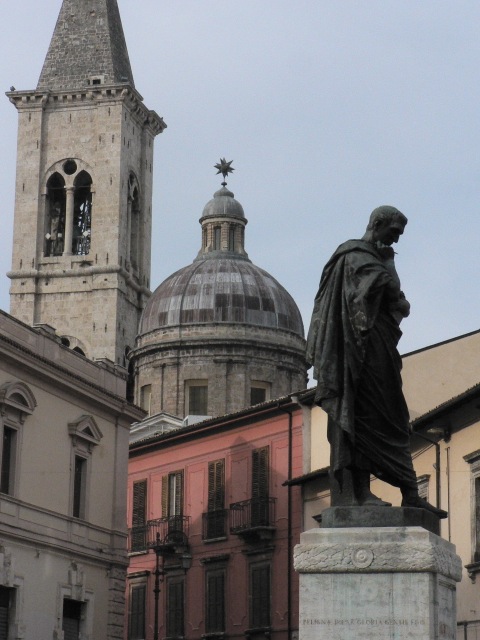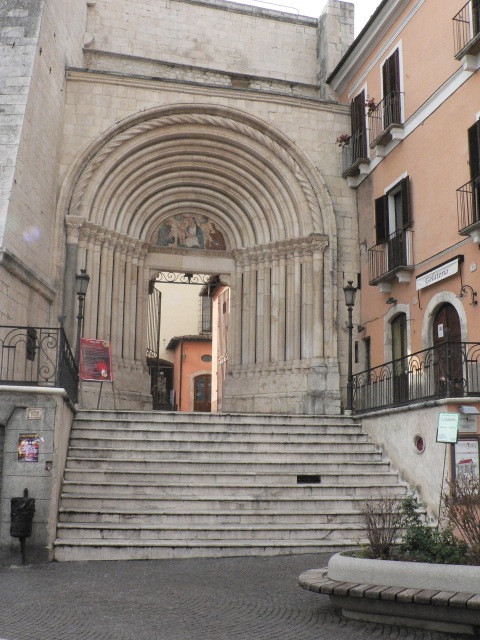Sulmona

Of all the many reasons I love Italy, one of the principal is the ability to change your world in a very short period. By which I mean architecture and food, landscape and dialect, wine and art. In the United States one would need to fly to another country to find the sort of change that, in Italy, a train trip of two hours will offer. What a remarkable feature of the country that is not really unified at all (despite the fact that we have just celebrated the 150th anniversary of its unification.)
Before the year ended, and in need of a brief change of world, we departed for a two day, overnight trip into Abruzzo. Most Romans have roots in this region, one of my single favorites, dramatically wild, with warm, kind people, unspoiled cities and landscapes, my beloved Transumanza, two of Italy’s largest and most varied national parks and source to some of my favorite foods. Italy’s best saffron, lentils and (red) garlic are all from Abruzzo.
While we’ve planned day-trips to Sulmona for our travelers, we are always pleased when travelers feel that Sulmona’s deep history requires extra, unhurried time, time to spend wandering its well ordered streets and gaze long at the mountainous contours (the wild and spectacular Parco Nazionale della Majella) that ring the town.
We have several appealing small hotels to propose here, perfect for a night or two spent in this city of 25,000.
When we arrived in Sulmona, after a dramatic train trip on the trim Interegional train (where you often will be the only passenger in the carriage, and where the fare is $12 for a three-hour trip), we were giddy after three hours of increasingly interesting, untamed scenery
as the train ascended altitude to its off-the-beaten path destination.

In our hotel, the concierge, a lovely Canadian who lives permanently now in Sulmona, told us how much she appreciated Sulmona for its good air, good food, and very good water.
Good water indeed, marvelous and icey cold, as Isabel verified as she sampled it from one of several elegant city fountains.

As time went on, and we became more and more fond of Sulmona, we wondered : in how many other cities in the world can a little girl can stand by a medieval aqueduct and blow soap bubbles below the steps of a 13th century church ?
Sulmona’s recorded history begins with the Romans. Ovid (43 BC – 17 AD), one of the most sympathetic of all poets, was born here
and refers often and affectionately to Sulmona in his poetry; in turn, he is a figure much beloved by the Sulmonesi. His poetry is read in school beginning with the first grade.
Sulmona was a Roman colony, and the magnificent square, Piazza Garibaldi, now site of an annual jousting tournament involving hundreds of citizens in 16th century costume reproductions, was originally the city’s Forum. Sulmona became a free commune under the Normans and under Frederick II an aqueduct was built in the town, one of the most important constructions in the region. The city was considerably more important than its neighbor L’Aquila, and was a major stop on the trade route between Rome and Naples. With the arrival of the Angevins, Sulmona lost its power, though it continued to grow, within the next centuries developing a flourishing industry in each paper manufacturing and the working of gold. In 1706, much of the medieval city was destroyed by the earthquake, though several remarkable structures are intact, including San Panfilo
Palazzo Annunziata
the Aqueduct
and the portal of San Francesco della Scarpa.
Much of the city was then reconstructed – this late 18th century doorway, for example.
When on the way home I told the train conductor that we had so enjoyed Sulmona, he asked me if perhaps I was there to buy my wedding confetti.
Then he saw Isabel
(who was photographing the passing town of Celano).
and said, no. Perhaps I was there to eat ? As restaurants were so good in Sulmona.
This was in fact true. We had two outstanding meals, one of which was in the company of the most charismatic waiter-in-training, Aldo.

He joined us at the table, and enagaged Isabel, between courses, in Uno Due Tre Stella ! and hide and go seek.
The second was at one of my dream “Zero Kilometer” restaurants, one I am eager to introduce you to, which keeps to my ideal of exclusively local and seasonal cooking and tells you clearly on the menu (Le Origini dei Nostri Piatti) the specific supplier of all — from olive oil to garlic — of its primary ingredients.

It is open only at lunch, as the owners are busy in the afternoon running Sulmona’s very best food store.
But back to the confetti.
White for weddings, blue for christenings of boys, pink for christenings of girls, silver for 25th wedding anniversaries, gold for 50th wedding anniversaries… Nearly every consequential family event in Italy has confetti, and traditionally these sugar covered Sicilian (Jordan) almonds come from Sulmona. They are addictively delicious when purchased on the spot, the almonds crisp and fresh, the candy cover (with its heady smell) not too sweet. Variants have centers of chocolate, hazelnut, coffee beans, rosolio(a tangerine liquor), cinammon and anise, and some are confectioned in the form of edible flower bouquets (mazzolini), nosegays, party favors or fruit baskets. They are bright and cheerful and more than a little imaginative.
The ancient Romans began the tradition of the bomboniera, the pouch containing the favors, and the confetti are still produced in machines that recall the past. And the stores in town that sell them seem from the past too.
Please let us know if we may include Sulmona on your next itinerary — as a day trip from Rome, or for an overnight or two, or en route to Puglia, or of course to another Abruzzo destination. You will find us here this spring participating in one of the most remarkable Easter celebrations in Italy.
Buon Anno !

Meet Marjorie
Insider’s Italy is an experienced family business that draws on my family’s four generations of life in Italy. I personally plan your travels. It is my great joy to share with you my family’s hundred-year-plus archive of Italian delights, discoveries and special friends.

















